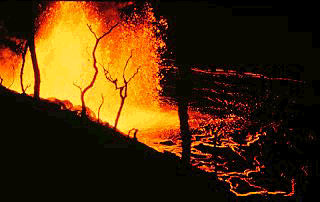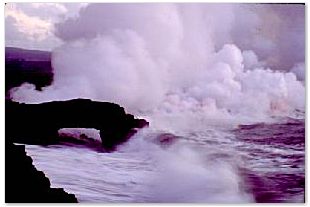The Earth's Atmosphere & Ocean
 The Early Earth
The Early EarthDuring the early period the Earth endured numerous enormous impacts, making the surface very hot. Gases, particularly CO2, locked up in the rock escaped via out-gassing in volcanos and lava flows. These impacts also deposited enormous volumes of gas, and possibly water from the enumerable, early comet impacts. This gave us our earliest atmosphere and oceans.
Atmosphere
Earth had a gaseous atmosphere, perhaps even rather thick, (heavy, and
thus with an increased pressure at the surface). However, NO OXYGEN!!

Early Oceans
Very early oceans are also suggested based on the discovery of 3.8-4.0
b.y.o. metamorphic rock, which came from earlier sedimentary rock,
which could only have formed at the bottom of an ocean. Carbonates,
starting as atmospheric CO2, dissolving into the ocean, then
precipitating out as carbonate rocks, are found to be 3.8 b.y.o.
Changes in the Earth's Atmosphere
At the start of the Proterozoic Era, 2.5 b.y.a.,
we see evidence of the oldest multi-celled life.
Very important environmental changes were occurring on Earth.
The Amount of CO2 was decreasing, while the amount of O2
was increasing! The evidence for increased Oxygen is found
in rocks. Oxidized rocks began to appear in the geological
record about 2.5 b.y.a. (previous to this, there was little
oxygen in the atmosphere).
Environmental changes were partially responsible for this, since volcanos are a source of CO2 gas, and they were subsiding. Also, the oceans absorb CO2 from the air (still does), locking it up in carbonate rocks. But the most important cause for changes in the atmosphere was the rise of photosynthetic bacteria and plants, producing O2! Because no geological, only biological-life can produce O2 in large quantities, the presence of O2 in the atmosphere of a planet or moon is an indication for LIFE.
Today, the atmosphere is composed of 76% N2 and 23% O2 by weight.